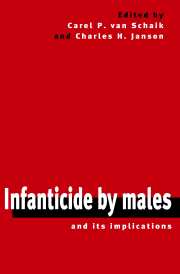Book contents
- Frontmatter
- Contents
- List of Contributors
- Foreword
- Infanticide by males: prospectus
- Part I Introduction
- Part II Infanticide by males: case studies
- 4 Infanticide in red howlers: female group size, male membership, and a possible link to folivory
- 5 Infanticide in hanuman langurs: social organization, male migration, and weaning age
- 6 Male infanticide and defense of infants in chacma baboons
- 7 Infanticide by males and female choice in wild Thomas's langurs
- 8 The evolution of infanticide in rodents: a comparative analysis
- 9 Infanticide by male birds
- Part III Behavioral consequences of infanticide by males
- Part IV Infanticide by females
- Part V Conclusion
- References
- Species index
- Subject index
6 - Male infanticide and defense of infants in chacma baboons
Published online by Cambridge University Press: 04 November 2009
- Frontmatter
- Contents
- List of Contributors
- Foreword
- Infanticide by males: prospectus
- Part I Introduction
- Part II Infanticide by males: case studies
- 4 Infanticide in red howlers: female group size, male membership, and a possible link to folivory
- 5 Infanticide in hanuman langurs: social organization, male migration, and weaning age
- 6 Male infanticide and defense of infants in chacma baboons
- 7 Infanticide by males and female choice in wild Thomas's langurs
- 8 The evolution of infanticide in rodents: a comparative analysis
- 9 Infanticide by male birds
- Part III Behavioral consequences of infanticide by males
- Part IV Infanticide by females
- Part V Conclusion
- References
- Species index
- Subject index
Summary
Introduction
Sexually selected infanticide is relatively widespread among primates, but has been documented primarily in one-male–multifemale reproductive units, e.g., in guenons (Cercopithecus spp.) (Butynski 1982; Fairgrieve 1995), langurs (Presbytis spp.) (Hrdy 1974; Newton 1988; Sommer 1994), howler monkeys (Alouatta spp.) (Crockett & Sekulic 1984), and mountain gorillas (Gorilla gorilla berengei) (Fossey 1984; Watts 1989). Although male infanticide has been invoked as a selective force in multimale–multifemale groups, such as in macaques (Macaca fascicularis) (van Noordwijk 1985), capuchin monkeys (Cebus olivaceus) (O'Brien 1991), and chimpanzees (Pan troglodytes) (Smuts & Smuts 1993), it has rarely been observed in these species (e.g., Valderrama et al. 1990; Camperio Ciani 1984) or follows patterns partly inconsistent with Hrdy's (1974) sexual selection hypothesis (Hiraiwa-Hasegawa & Hasegawa 1994). Thus current data suggest that the presence of multiple males in a primate group discourages infant-killing by other males.
Relative to one-male groups, the presence of additional, reproductively active males may both dilute the benefits of infanticide and increase its costs. Exploitation of the reproductive opportunity created by infanticide depends upon the perpetrator's ability to monopolize subsequent fertilizations, which is a function of social variables such as the number of males in a group, the intensity of male–male mating competition, and the potential for effective mate guarding.
- Type
- Chapter
- Information
- Infanticide by Males and its Implications , pp. 123 - 152Publisher: Cambridge University PressPrint publication year: 2000
- 65
- Cited by

